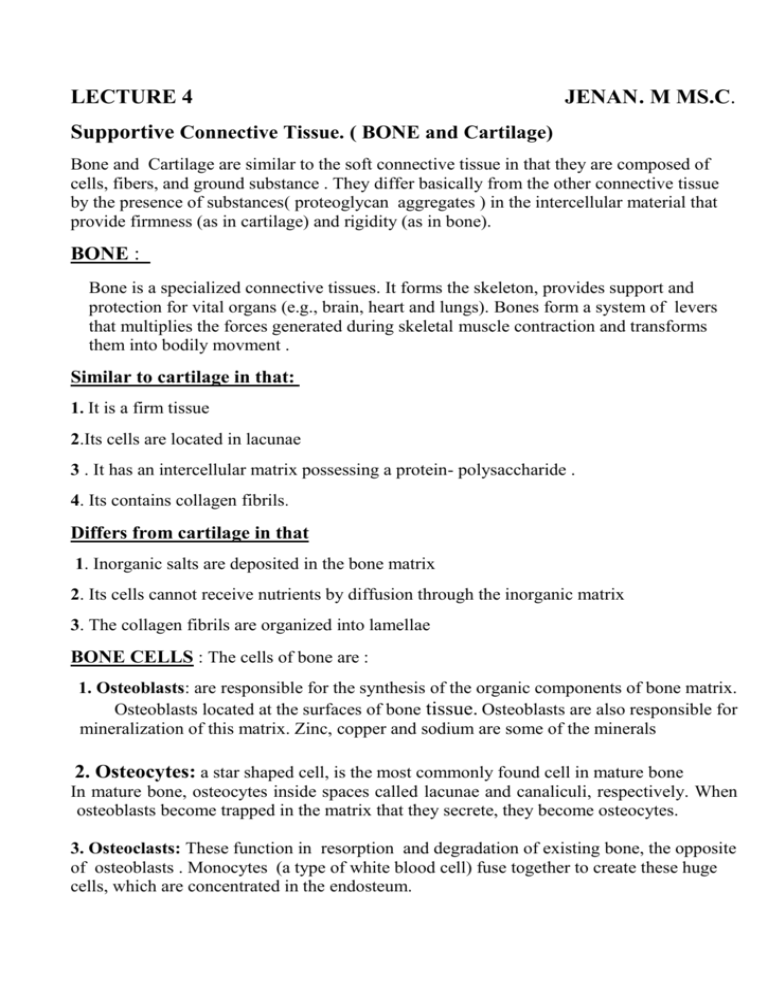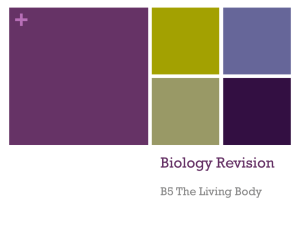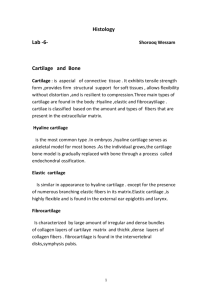Supportive Connective Tissue .(BONE and Cartilage).
advertisement

LECTURE 4 JENAN. M MS.C. Supportive Connective Tissue. ( BONE and Cartilage) Bone and Cartilage are similar to the soft connective tissue in that they are composed of cells, fibers, and ground substance . They differ basically from the other connective tissue by the presence of substances( proteoglycan aggregates ) in the intercellular material that provide firmness (as in cartilage) and rigidity (as in bone). BONE : Bone is a specialized connective tissues. It forms the skeleton, provides support and protection for vital organs (e.g., brain, heart and lungs). Bones form a system of levers that multiplies the forces generated during skeletal muscle contraction and transforms them into bodily movment . Similar to cartilage in that: 1. It is a firm tissue 2.Its cells are located in lacunae 3 . It has an intercellular matrix possessing a protein- polysaccharide . 4. Its contains collagen fibrils. Differs from cartilage in that 1. Inorganic salts are deposited in the bone matrix 2. Its cells cannot receive nutrients by diffusion through the inorganic matrix 3. The collagen fibrils are organized into lamellae BONE CELLS : The cells of bone are : 1. Osteoblasts: are responsible for the synthesis of the organic components of bone matrix. Osteoblasts located at the surfaces of bone tissue. Osteoblasts are also responsible for mineralization of this matrix. Zinc, copper and sodium are some of the minerals 2. Osteocytes: a star shaped cell, is the most commonly found cell in mature bone In mature bone, osteocytes inside spaces called lacunae and canaliculi, respectively. When osteoblasts become trapped in the matrix that they secrete, they become osteocytes. 3. Osteoclasts: These function in resorption and degradation of existing bone, the opposite of osteoblasts . Monocytes (a type of white blood cell) fuse together to create these huge cells, which are concentrated in the endosteum. Types of Bone 1. Compact Bone: The hard outer layer of bones is composed of compact bone tissue, so-called due to its minimal gaps and spaces .This tissue gives bones their smooth, white, and solid appearance. Compact bone may also be referred to as dense bone 2. Spongy Bone: Cancellou s bone or spongy bone, is one of two types of osseous tissue that form bones is less dense, softer, weaker, and less stiff. It typically occurs at the ends of long bones. Cancellous bone is highly vascular and frequently contains red bone marrow where hematopoiesis, the production of blood cells, Cartilage: is characterized by an extracellular matrix enriched with glycosaminoglycans and proteoglycans, macromolecules that interact with collagen and elastic fibers. It contend three components ( cells, fibers, ground substance) Cells : all types of cartilage are comprised of cells called matrix, are elliptical cells with few microvilli. Chondrocytes produce protein, collagen fibers and ground substance ( e.g. chondroition sulphate). Cartilage Types: 1. Hyaline cartilage: ( most abundant type) Is the most common type of cartilage, its composed of fine collagen fibers embedded in a gel-type matrix. Fresh hyaline cartilage is bluish-white and translucent. mature hyaline cartilage is characterized by small aggregation of chondrocytes. Location: in the articular surfaces of the movable joints, in the walls of large respiratory passges ( nose, larynx, trachea, bronchi) , in the ventral ends of ribs, in the epiphyseal plate and in the ends of long bones. Function : flexible , provides support, smooth surfaces and allows movement at joints. 2. Fibro Cartilage : Is a tissue intermediate between dense connective tissue and hyaline cartilage. Its consist of alternating layers of hyaline cartilage matrix and thick layers of denes collagen fibers. Location: In the intervertebral discs, pubic symphysis, in association with denes collagenous tissue in joint capsules, ligaments and the connections of some tendons to bone. Function: support and rigidity to attached surrounding structures , and is the strongest of the three type of cartilage. 3. Elastic Cartilage: elastic cartilage is essentially very similar to hyaline cartilage except that it contains an abundant network of fine elastic fibers in addition to collagen. Location: In the auricle of the ear, the walls of the external auditory canals, , the epiglottis, and the cuneiform cartilage in the larynx. Function: provides support to surrounding structures and helps the define and maintain the shape of the area in which is present e.g. external ear








